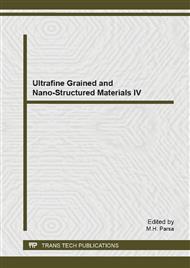[1]
Ch. Sun, H. Lee, J. Yang, Ch. Wu, The simultaneous electrochemical detection of ascorbic acid, dopamine, and uric acid using graphene/size-selected Pt nanocomposites, Biosens. Bioelectronics 26 (2011) 3450–3455.
DOI: 10.1016/j.bios.2011.01.023
Google Scholar
[2]
K.A. Frith, J.L. Limson, Reprint of pH tuning of Nafion, for selective detection of tryptophan, Electrochim. Acta 55 (2010) 4281-4286.
DOI: 10.1016/j.electacta.2010.03.098
Google Scholar
[3]
G.P. Jin, X.Q. Lin, The electrochemical behavior and amperometric determination of tyrosine and tryptophan at a glassy carbon electrode modified with butyrylcholine, Electrochem. Commun. 6 (2004) 454-460.
DOI: 10.1016/j.elecom.2004.05.014
Google Scholar
[4]
A.A. Ensafi, R. Hajian, Determination of tryptophan and histidine by adsorptive cathodic stripping voltammetry using H-point standard addition method, Anal. Chim. Acta 580 (2006) 236-243.
DOI: 10.1016/j.aca.2006.07.076
Google Scholar
[5]
M.M. Yust, J. Pedroche, J.G. Calle, J. Vioque, F. Millan, M. Alaiz, Effect of nixtamalization on the chemical and functional properties of maize, Food Chem. 85 (2004) 317-324.
Google Scholar
[6]
S. Oshite, M. Furukawa, S. Igarashi, Homogeneous liquid–liquid extraction method for the selective spectrofluorimetric determination of trace amounts of tryptophan, Analyst 126 (2001) 703-707.
DOI: 10.1039/b100114k
Google Scholar
[7]
G. Chen, J.S. Cheng, J.N. Ye, Application of a novel micro-injector in the determination of indole derivatives in the rat pineal gland by capillary electrophoresis with electrochemical detection, Fresenius' J. Anal. Chem. 370 (2001) 930-934.
DOI: 10.1007/s002160100834
Google Scholar
[8]
J. Saurina, S.H. Cassou, E. Fabregas, S. Alegret, Determination of tryptophan in feed samples by cyclic voltammetry and multivariate calibration methods, Analyst 124 (1999) 733-737.
DOI: 10.1039/a901149h
Google Scholar
[9]
J.B. Raoof, R. Ojani, M. Baghayeri, Simultaneous electrochemical determination of glutathione and tryptophan on a nano-TiO2/ferrocene carboxylic acid modified carbon paste electrode, Sens. Actuators B 143 (2009) 261-269.
DOI: 10.1016/j.snb.2009.08.046
Google Scholar
[10]
S. Shahrokhian, L. Fotouhi, Carbon paste electrode incorporating multi-walled carbon nanotube/cobalt salophen for sensitive voltammetric determination of tryptophan, Sens. Actuators B 123 (2007) 942-949.
DOI: 10.1016/j.snb.2006.10.053
Google Scholar
[11]
S.K. Park, K.D. Kim, H.T. Kim, Preparation of silica nanoparticles: determination of the optimal synthesis conditions for small and uniform particles, Coll. Surf. A: Physicochem. Eng. Aspects, 197 (2002) 7-17.
DOI: 10.1016/s0927-7757(01)00683-5
Google Scholar
[12]
M. Arvand, M.A. Zanjanchi, A. Islamnezhad, Zeolite-Modified Carbon-Paste Electrode as a Selective Voltammetric Sensor for Detection of Tryptophan in Pharmaceutical Preparations, Anal. Letters, 42 (2009) 727-738.
DOI: 10.1080/00032710902721964
Google Scholar
[13]
S. Szunerits, Y. Coffinier, E. Galopin, J. Brenner, R. Boukherroub, Preparation of boron-doped diamond nanowires and their application for sensitive electrochemical detection of tryptophan, Electrochem. Communications 12 (2010) 438-441.
DOI: 10.1016/j.elecom.2010.01.014
Google Scholar
[14]
A. Babaei, M. Zendehdel, B. Khalilzadeh, A. Taheri, Simultaneous determination of tryptophan, uric acid and ascorbic acid at iron(III) doped zeolite modified carbon paste electrode, Coll. Surfaces B: 66 (2008) 226-232.
DOI: 10.1016/j.colsurfb.2008.06.017
Google Scholar
[15]
K.J. Huanga, Ch.X. Xua, W. Zh. Xiea, W. Wang, Electrochemical behavior and voltammetric determination of tryptophan based on 4-aminobenzoic acid polymer film modified glassy carbon electrode, Coll. Surfaces B 74 (2009) 167-171.
DOI: 10.1016/j.colsurfb.2009.07.013
Google Scholar
[16]
Ch. Li, Y. Ya, G. Zhan, Electrochemical investigation of tryptophan at gold nanoparticles modified electrode in the presence of sodium dodecylbenzene sulfonate, Coll. Surfaces B 76 (2010) 340-345.
DOI: 10.1016/j.colsurfb.2009.11.017
Google Scholar
[17]
Y. Guo, Sh. Guo, Y. Fang, Sh. Dong, Gold nanoparticle/carbon nanotube hybrids as an enhanced material for sensitive amperometric determination of tryptophan, Electrochim. Acta 55 (2010) 3927-3931.
DOI: 10.1016/j.electacta.2010.02.024
Google Scholar
[18]
X. Tanga, Y. Liua, H. Houb, T. Youa, Electrochemical determination of L-Tryptophan, L-Tyrosine and L-Cysteine using electrospun carbon nanofibers modified electrode, Talanta 80 (2010) 2182-2186.
DOI: 10.1016/j.talanta.2009.11.027
Google Scholar


